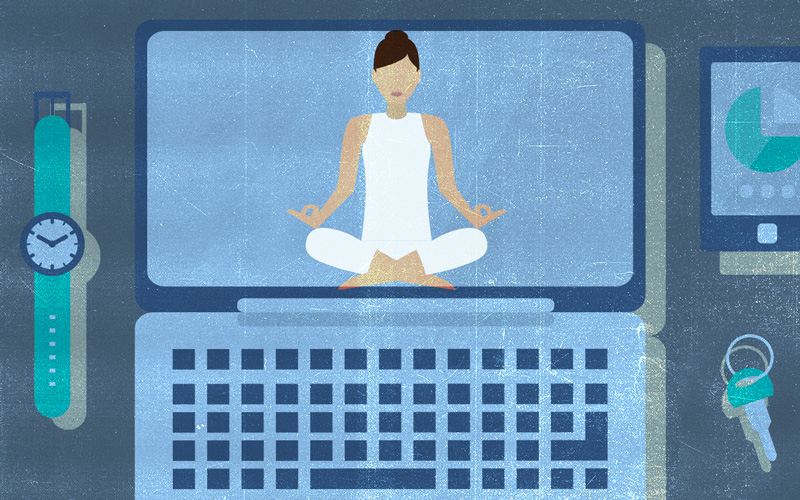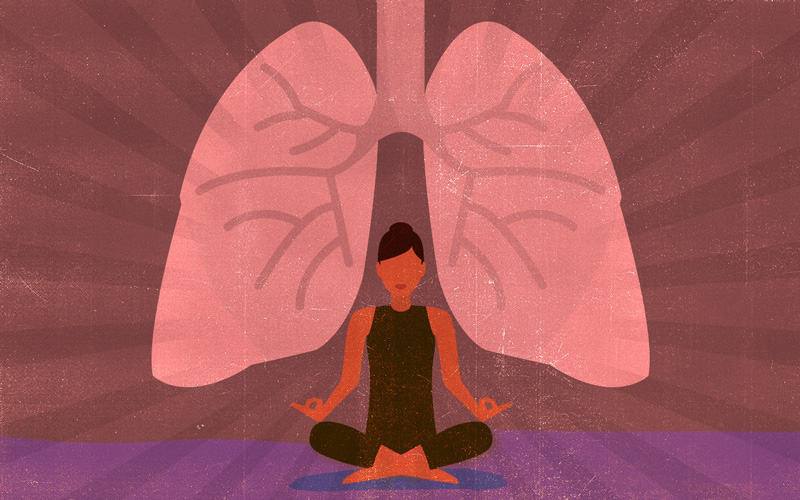


Keeping the zen in college
Illustrations by Jeffrey C. Chase April 20, 2020
Prof. Amy Griffin teaches college students how to make the most of mindfulness
As the coronavirus (COVID-19) pandemic unfolds, there are few certainties. Among them? Netflix is a saving grace. Go ahead and binge that show about a tiger-obsessed man in Oklahoma or a money-laundering accountant in the Ozarks. Getting lost in someone else’s story is a reprieve from your own. Zoning out is good for you.
But — as it turns out — zoning in is even better.
This is the philosophy behind mindfulness, the practice of paying close attention to the present moment. This means tuning in to external happenings — say, the sound of a dog breathing at your feet or the sight of a tree branch blowing in the wind. It also means bringing attention to your internal state. Rather than trying to suppress or ignore thoughts, emotions or sensations as they arise, the goal is acknowledging these feelings — and letting them pass — without judgement. Research indicates the benefits are myriad: less stress, more self-compassion and greater immunity.
“Escape activities — like bingeing on Netflix — are fine,” said Amy Griffin, associate professor in the Department of Psychological and Brain Science in the College of Arts and Sciences at the University of Delaware who specializes in mindfulness training for the 20-something demographic. “There’s nothing wrong with that. But introducing a little bit of mindfulness into your day can ease some suffering longer term. Such a practice allows us to feel comfortable with being uncomfortable, so we’re better equipped to deal with whatever comes up.”
Since the beginning of the spring semester, Griffin has been teaching a class for undergraduate neuroscience and psychology students on mindfulness and the brain. But once the coronavirus outbreak forced the UD community — along with the rest of the world — into quarantine, she figured more people might be craving a stress-coping mechanism, so she launched a free, four-week, virtual class on mindfulness for graduate students, happening now. She will also run a second section beginning April 30. Participants in each course will learn the benefits of two major mindfulness strategies: the body-mind integration you see with activities like yoga or deep-breathing exercises, and meditation.
“People think you need to be a monk on a mountaintop to do this kind of thing,” Griffin said. “But if you can breathe, you can meditate.”
Big caveat: Not all meditators are created equal. Take 20-somethings, for instance.
“They don’t respond very well to being told they need to sit on a cushion with their thoughts for 20 minutes a day,” said Griffin, whose classes cater specifically to this demographic. “That kind of strict sitting-with-your-thoughts thing may work for some people, but for college-aged students, graduate students and people with a lot on their plate, it’s good to have a variety of options.”
For these individuals, Griffin, who is training as a mindfulness teacher with the North Carolina-based Koru Center, suggests guided meditation apps — like the Ten percent Happier or Insight Timer options — so that someone is holding your hand through the process. She also recommends a simple breath practice in which you breathe in for four counts, hold for two counts and breathe out for six counts — this will “trick the brain into relaxing,” she said. Shoot for 10 mindful minutes per day, Griffin added, keeping in mind that consistency is more important than quantity.

But if you’re finding it difficult to devote any time at all to nothing but mindfulness, don’t despair. It is possible to bring such a practice to existing activities. Consider the (socially distanced) walk you are already taking around the neighborhood every afternoon. Don’t spend it fretting over what happened yesterday or what might happen tomorrow. Rather, focus on the present moment by paying mind to the sensory input all around you — the sound of a leaf crunching underfoot, the sight of paint chipping from a nearby fire hydrant, or the smell of barbeque coming from the house next door.
When it comes time to brush your teeth? Don’t rush through the ritual while thinking about the answers to your last online quiz or that email you need to send your boss in the morning. Instead, bring attention to the circular motion of the activity or the sensation of the bristles in your mouth.
“Focusing on just one thing at a time feels like a luxury, but it’s the way we should be conducting ourselves all the time for brain health and wellbeing,” Griffin said. “We love to multitask, but multitasking is actually very bad for the brain. If you can focus on just one thing at a time, you’ll be amazed at how much more you get out of it.”
This is all easier said than done, as humans are easily hijacked by every passing notion.
“We give so much credence to our thoughts,” Griffin said. “We take them so seriously. And they’re really just thoughts. Most of the time, we can’t even verify whether they’re true.”
Part of the problem is that, when a thought or feeling pops into the head of a typical human, the usual response is not to simply acknowledge it and let it go but, rather, to assign a story to it. Say, for example, you feel irritated by your spouse or your siblings during this period of national lockdown, in which families are enduring forced togetherness. The urge is rarely to feel the irritation and move on. Instead, people pile on extra feelings of guilt or anger, thinking something along the lines of: It is so selfish to feel irritated when so many people are truly suffering.
“You judge yourself, and you try to analyze, analyze, analyze,” Griffin said. “But you can’t think your way out of a feeling. The counterintuitive practice is to watch the feeling arise — and then to watch it go away.”
And remember, Griffin said, mindfulness is not meant only for some enlightened group of sherpas or transcendent yogis. People who struggle to stay in the present moment likely have the most to gain, so — if that’s you — keep at it.
“Something I hear frequently is ‘I can’t meditate, because I can’t shut off my thoughts,’ ” Griffin said. “But mindfulness is not about achieving a blank mind. It’s about becoming familiar with what your mind is doing. Whatever strong emotion comes up, you can handle it, as long as you face it. Lean into it. Don’t try to stuff it down.”
Besides, if you ever do want a blank mind?
You already have Netflix for that.
Contact Us
Have a UDaily story idea?
Contact us at ocm@udel.edu
Members of the press
Contact us at 302-831-NEWS or visit the Media Relations website

